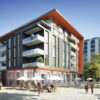Ottawa is in a time of transition. With new infrastructure and real estate projects such as light rail, Zibi and Trinity Centre at Bayview Station poised to transform how residents live, work and commute, the city’s planners and innovators say flexibility and ambition are key for the next few decades in Canada’s capital.
In December 2016, city council launched a planning study to look at Ottawa’s 20-year trajectory. As Ottawa moves toward a projected 1.2 million people – or 1.8 million including nearby municipalities in Quebec – the planning study identified several important areas of change. Housing and transportation are top of mind with the impending launch of phase one of the light rail transit (LRT) plan. Also on the priority list are economic development, sustainability and culture.
As Invest Ottawa CEO Michael Tremblay puts it, today’s employers, developers and property managers need to think about tomorrow’s workforce. When it comes to attracting people, “you’re selling the whole experience, and part of the experience is the city itself,” he says.
(Sponsored)

Giving Guide 2025: Ottawa Regional Cancer Foundation
As Ottawa’s only Community Cancer Hub, we are delivering Supportive Cancer Care through dynamic collaborations with over 70 diverse community partners.

Family-owned Coke Canada Bottling investing to grow in Ottawa-Gatineau
Have you ever wondered where your favourite Coca-Cola products come from? Few people in know that over 300 popular beverages products, like Coca-Cola, Coke Zero, Fuze, Fanta, Monster Energy, A&W
So, who are tomorrow’s workers, and what do they want from their city?
Soley Soucie, regional director of Eastern Canada for recruitment consultancy Hays Canada, says millennials and Generation Z have a stronger tie to purpose than their predecessors. Workers increasingly want to work for companies that are aligned with their own ethical views, with a special focus on sustainability in Gen Z. They want to be engaged, and Soucie says companies adapting to this shift are “miles ahead” when it comes to attracting young talent.
Hand-in-hand with purpose is culture, with more companies – especially young tech companies – striving for a fun, community-like workplace.
“People are wanting a culture where they have community, (where) they have a connection with people that they work with,” she says. “It’s the hardest thing to create.”
Downtown developments
Tremblay says companies coming to Ottawa are increasingly going downtown, because their employees want to not only work, but live in the downtown core. And they’re not content with old government buildings – companies like Shopify demand upgraded commercial space that can be adapted to workplace culture trends.
Ottawa is unique in that it still has a great deal of downtown space available for development, which means that as more companies make their way downtown, the younger workforce can start living downtown as well, says Soucie.
That’s the experience people are looking for, says Tremblay, adding that the plan for the future of Bayview Yards includes insight from the many millennials who currently work there. “They have very clear demands – they want restaurant space, they want cultural experiences, they want excitement.”
The suburban, commuter-centric dream is fading, says Zibi president Jeff Westeinde. He describes a quarter-acre property in the suburbs with a two-car garage as a fading marker of success.
“Today, success for me is, I don’t need a car,” says Westeinde. He says today’s home buyers (and renters) want to bike and walk to work or the grocery store whenever possible.

“That’s driven the demand for mixed-use communities where you can live, work, play, learn, all in the same neighborhood,” he says, highlighting near-downtown Zibi as a prime example. At minimum, people want to be close to transit, leading to developments such as the towers planned at Blair and Bayview stations.
Jason Burggraaf, executive director of the Greater Ottawa Home Builders’ Association, says Ottawa has been exceeding its density targets, and not just in the form of condo buildings.
In areas such as Kanata, more traditional residential areas are continuing to grow, often in the form of multi-unit dwellings replacing single-family homes. However, in many neighbourhoods Burggraaf says residential and commercial buildings are starting to become interspersed.
“You have to think about residential, commercial and transit planning, all within the same breath,” he says. “Much like you need people on top of a transit station to make that transit viable, you need people living within and amongst stores and retail in order to keep those shops open … one shouldn’t be thought of without the other.”
“You need people living within and amongst stores and retail in order to keep those shops open … one shouldn’t be thought of without the other.”
Jason Burggraaf, executive director of the Greater Ottawa Home Builders’ Association
Autonomous vehicles
Whether it’s a condo tower, a house in the suburbs or something in between, the key factor affecting how people live and work is what links those two worlds: transit.
In the near future, there’s light rail, which will connect Ottawa’s suburbs to the downtown core faster than ever before. Also in sight are autonomous vehicles, which Westeinde notes could affect Ottawa’s development in multiple ways.
“I think the autonomous vehicle could have as big an impact on city planning as the car,” says Westeinde, adding that planners need to think ahead: “Don’t wait for the AVs to show up and then react.”
Ottawa is a hub for autonomous vehicle innovation, with an upcoming integrated test track under development in Kanata North and Nepean as well as an ecosystem of companies working to develop core technology and infrastructure. AV technology is already at work in the mining industry, and soon farming – Tremblay says last-mile pods will be next in line for public use, transporting people from transit hubs to their final destinations.
AV technology revolves around connectivity, says Tremblay, something Ottawa excels at. The city is home to companies such as BlackBerry QNX, Ericsson and Juniper Networks, all of which are working on the communication technology central to not just autonomous vehicles, but more broadly the concept of smart cities.
What is a smart city? Tremblay says it’s a city that anticipates and responds to what citizens want and need.
“The most important basic enabler is that core infrastructure around communications,” he says. “And we happen to have in our backyard all the companies that know how to do that.”
Westeinde says the ability to anticipate future changes such as autonomous vehicles is also key for today’s residential and commercial developments. For example, Zibi’s underground parking is being built to accommodate the possibility of AV technology: if autonomous vehicles remove the need for all that parking, the space can be turned into a walkway, or even used for urban agriculture.

Tremblay says the combination of new technology and the possibility for downtown developments make the next two decades critical to the future of Ottawa.
“We’ve got all this space in the core,” he says. “There’s so much we can do; we’ve got to make it exciting.” Space is a finite resource, he adds, and it’s important to be ambitious, future-focused and innovative in our use of it.
Westeinde says that as Ottawa grows, he wants infrastructure and development to be centred around what makes this city special – and livable, a key focus for Ottawa’s planning study and for the concept of smart cities.
“We’ve done a good job of making sure that we do have that balance and we can mingle urbanity with play and mobility,” he says. “Nobody gets to live like we do.”
This article originally appeared in the 2018-19 BOMA Ottawa Commercial Space Directory. Read the full publication here:




